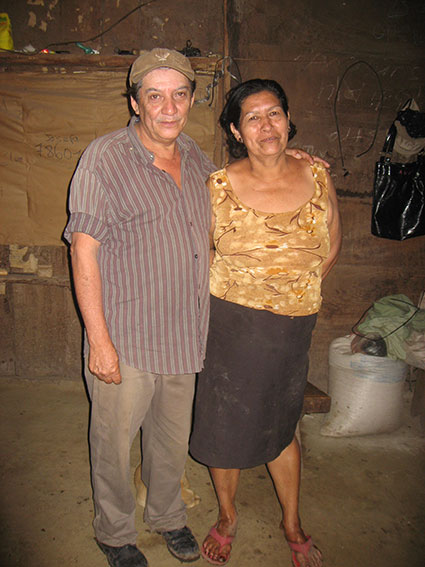 In November 2015, GRID Alternatives’ International Program volunteers installed a solar-powered drip irrigation system on a small farm in Jucuapa, Matagalpa, Nicaragua. Volunteers installed a solar-powered submersible pump that moves water from a well into a tank, and then gravity kicks in to move the water through the tubes to the plants in the farmer's field drip by drip.
In November 2015, GRID Alternatives’ International Program volunteers installed a solar-powered drip irrigation system on a small farm in Jucuapa, Matagalpa, Nicaragua. Volunteers installed a solar-powered submersible pump that moves water from a well into a tank, and then gravity kicks in to move the water through the tubes to the plants in the farmer's field drip by drip.
The system was installed on the farm of Juan Jose Castro and Santa Garcia Mirando, organic producers who live with three of their five children on a farm in the community of Jucuapa, Matagalpa. Juan Jose belongs to a national agricultural organization called the UNAG, Unión Nacional de Agricultores y Ganaderos. UNAG is one of the largest agricultural groups in Nicaragua for small and medium sized farmers, with more than 72,000 members, offering them support, training, and opportunities to improve their businesses. Santa Garcia Mirando belongs to a women's cooperative through UNAG where she has participated in workshops on sustainable farming such as how to elaborate organic fertilizer. She has also participated in facilitated talks about gender equality.
Before the installation of the system, their main crops were beans, millet, passion fruit, and squash. For the past few years, farmers in the community have lost many of their crops due to extreme droughts. For this reason, Juan Jose and Santa Garcia Mirando decided to construct a well on their land to collect water to use for his crops. This well became the water source for the drip irrigation system that GRID volunteers installed.
The drip irrigation system will allow the family to diversify their crops and have a reliable irrigation source in the dry and rainy seasons, saving the family time and increasing income. The family plans to use the increased income to pay for their day to day needs as well as to support their children to continue studying, while also making some improvements to their home.
Agriculture continues to be one of the dominant economic sectors of the country. Subsistence farming is one of the most common livelihoods in the rural communities we work in Nicaragua. Many families have a small plot of land where they grow just enough food to consume like corn, beans and wheat and if there surplus they trade it or sell it at the market for other necessities.
Small farmers face a number of challenges. Many farmers rely on diesel-powered or gasoline-powered motors to pump water to their crops, which is very costly, polluting, and time consuming for the farmer to travel to obtain fuel. Those who cannot afford a generator, irrigate their crops by hauling water in buckets by hand from a well or nearby river. In both cases, watering crops in the dry season is difficult due to the hot climate and lack of water accessibility, limiting the farmer’s annual yield.
Connecting to grid electricity is not an option for most farmers either because the electric grid is not nearby or because the electric company charges farmers a higher commercial rate if the electricity is used for irrigation.
By using solar-powered drip irrigation systems, farmers can save money, use water more efficiently, increase crop yields, reduce local pollution, add more locally produce to the market, improve the quality of their lives by having more disposable income to send their children to school, make improvements to their home, and get their crops to the local market faster.
Using a drip irrigation system also allows farmers to grow a wider variety of crops during dry season (May through October) like grenadine, papaya, passion fruit, cucumbers, tomatoes, carrots, sweet peppers and watermelon. Drip irrigation allows for greater flexibility for crop rotation cycles without damaging the soil.
While in the rural community, the group participated in cultural activities to better understand the “campesino” way of life. Before and after the solar project, the group traveled around the country to explore Nicaragua's scenery and experience various aspects of Nicaraguan food, music and culture.

